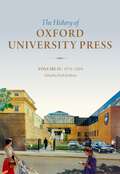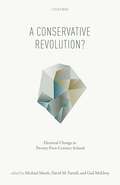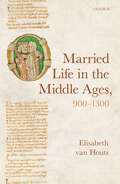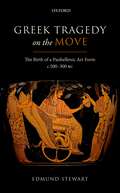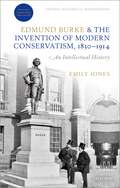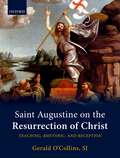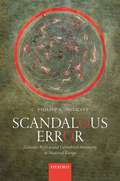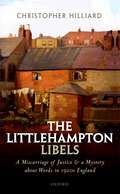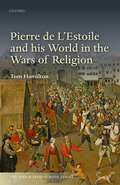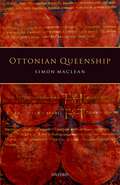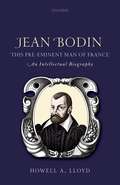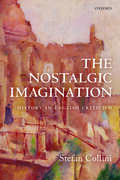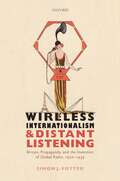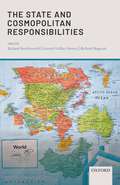- Table View
- List View
The History of Oxford University Press: 1970 to 2004 (History of Oxford University Press)
The story of Oxford University Press spans five centuries of printing and publishing. Beginning with the first presses set up in Oxford in the fifteenth century and the later establishment of a university printing house, it leads through the publication of bibles, scholarly works, and the Oxford English Dictionary, to a twentieth-century expansion that created the largest university press in the world, playing a part in research, education, and language learning in more than 50 countries. With access to extensive archives, the four-volume History of OUP traces the impact of long-term changes in printing technology and the business of publishing. It also considers the effects of wider trends in education, reading, and scholarship, in international trade and the spreading influence of the English language, and in cultural and social history - both in Oxford and through its presence around the world. In the decades after 1970 Oxford University Press met new challenges but also a period of unprecedented growth. In this concluding volume, Keith Robbins and 21 expert contributors assess OUP's changing structure, its academic mission, and its business operations through years of economic turbulence and continuous technological change. The Press repositioned itself after 1970: it brought its London Business to Oxford, closed its Printing House, and rapidly developed new publishing for English language teaching in regions far beyond its traditional markets. Yet in an increasingly competitive worldwide industry, OUP remained the department of a major British university, sharing its commitment to excellence in scholarship and education. The resulting opportunities and sometimes tensions are traced here through detailed consideration of OUP's business decisions, the vast range of its publications, and the dynamic role of its overseas offices. Concluding in 2004 with new forms of digital publishing, The History of OUP sheds new light on the cultural, educational, and business life of the English-speaking world in the late twentieth century.
The History of Oxford University Press: 1970 to 2004 (History of Oxford University Press)
by Simon Eliot Keith RobbinsThe story of Oxford University Press spans five centuries of printing and publishing. Beginning with the first presses set up in Oxford in the fifteenth century and the later establishment of a university printing house, it leads through the publication of bibles, scholarly works, and the Oxford English Dictionary, to a twentieth-century expansion that created the largest university press in the world, playing a part in research, education, and language learning in more than 50 countries. With access to extensive archives, the four-volume History of OUP traces the impact of long-term changes in printing technology and the business of publishing. It also considers the effects of wider trends in education, reading, and scholarship, in international trade and the spreading influence of the English language, and in cultural and social history - both in Oxford and through its presence around the world. In the decades after 1970 Oxford University Press met new challenges but also a period of unprecedented growth. In this concluding volume, Keith Robbins and 21 expert contributors assess OUP's changing structure, its academic mission, and its business operations through years of economic turbulence and continuous technological change. The Press repositioned itself after 1970: it brought its London Business to Oxford, closed its Printing House, and rapidly developed new publishing for English language teaching in regions far beyond its traditional markets. Yet in an increasingly competitive worldwide industry, OUP remained the department of a major British university, sharing its commitment to excellence in scholarship and education. The resulting opportunities and sometimes tensions are traced here through detailed consideration of OUP's business decisions, the vast range of its publications, and the dynamic role of its overseas offices. Concluding in 2004 with new forms of digital publishing, The History of OUP sheds new light on the cultural, educational, and business life of the English-speaking world in the late twentieth century.
A Conservative Revolution?: Electoral Change in Twenty-First Century Ireland
by Michael Marsh David M. Farrell Gail McElroyThe 2011 general election in the Republic of Ireland, which took place against a backdrop of economic collapse, was one of the most dramatic ever witnessed. The most notable outcome was the collapse of Fianna Fáil, one of the world's most enduring and successful parties. In comparative terms Fianna Fáil's defeat was among the largest experienced by a major party in the history of parliamentary democracy. It went from being the largest party in the state (a position it had held since 1932) to being a bit player in Irish political life. And yet ultimately, there was much that remained the same, perhaps most distinctly of all the fact that no new parties emerged. It was, if anything, a 'conservative revolution'. A Conservative Revolution? examines underlying voter attitudes in the period 2002-11. Drawing on three national election studies the book follows party system evolution and voter behaviour from boom to bust. These data permits an unprecedented insight into a party system and its voters at a time of great change, as the country went through a period of rapid growth to become one of Europe's wealthiest states in the early twenty-first century to economic meltdown in the midst of the international Great Recession, all of this in the space of a single decade. In the process, this study explores many of the well-established norms and conventional wisdoms of Irish electoral behaviour that make it such an interesting case study for comparison with other industrialized democracies.
Married Life in the Middle Ages, 900-1300 (Oxford Studies in Medieval European History)
by Elisabeth van HoutsMarried Life in the Middle Ages, 900-1300 contains an analysis of the experience of married life by men and women in Christian medieval Europe, c. 900-1300. The study focusses on the social and emotional life of the married couple rather than on the institutional history of marriage, breaking it into three parts: Getting Married - the process of getting married and wedding celebrations; Married Life - the married life of lay couples and clergy, their sexuality, and any remarriage; and Alternative Living - which explores concubinage and polygyny, as well as the single life in contrast to monogamous sexual unions. In this volume, van Houts deals with four central themes. First, the tension between patriarchal family strategies and the individual family member's freedom of choice to marry and, if so, to what partner; second, the role played by the married priesthood in their quest to have individual agency and self-determination accepted in their own lives in the face of the growing imposition of clerical celibacy; third, the role played by women in helping society accept some degree of gender equality and self-determination to marry and in shaping the norms for married life incorporating these principles; fourth, the role played by emotion in the establishment of marriage and in married life at a time when sexual and spiritual love feature prominently in medieval literature.
Married Life in the Middle Ages, 900-1300 (Oxford Studies in Medieval European History)
by Elisabeth van HoutsMarried Life in the Middle Ages, 900-1300 contains an analysis of the experience of married life by men and women in Christian medieval Europe, c. 900-1300. The study focusses on the social and emotional life of the married couple rather than on the institutional history of marriage, breaking it into three parts: Getting Married - the process of getting married and wedding celebrations; Married Life - the married life of lay couples and clergy, their sexuality, and any remarriage; and Alternative Living - which explores concubinage and polygyny, as well as the single life in contrast to monogamous sexual unions. In this volume, van Houts deals with four central themes. First, the tension between patriarchal family strategies and the individual family member's freedom of choice to marry and, if so, to what partner; second, the role played by the married priesthood in their quest to have individual agency and self-determination accepted in their own lives in the face of the growing imposition of clerical celibacy; third, the role played by women in helping society accept some degree of gender equality and self-determination to marry and in shaping the norms for married life incorporating these principles; fourth, the role played by emotion in the establishment of marriage and in married life at a time when sexual and spiritual love feature prominently in medieval literature.
Greek Tragedy on the Move: The Birth of a Panhellenic Art Form c. 500-300 BC
by Edmund StewartGreek tragedy is one of the most important cultural legacies of the classical world, with a rich and varied history and reception, yet it appears to have its roots in a very particular place and time. The authors of the surviving works of Greek tragic drama-Aeschylus, Sophocles, and Euripides-were all from one city, Athens, and all lived in the fifth century BC; unsurprisingly, it has often been supposed that tragic drama was inherently linked in some way to fifth-century Athens and its democracy. Why then do we refer to tragedy as 'Greek', rather than 'Attic' or 'Athenian', as some scholars have argued? This volume argues that the story of tragedy's development and dissemination is inherently one of travel and that tragedy grew out of, and became part of, a common Greek culture, rather than being explicitly Athenian. Although Athens was a major panhellenic centre, by the fifth century a well-established network of festivals and patrons had grown up to encompass Greek cities and sanctuaries from Sicily to Asia Minor and from North Africa to the Black Sea. The movement of professional poets, actors, and audience members along this circuit allowed for the exchange of poetry in general and tragedy in particular, which came to be performed all over the Greek world and was therefore a panhellenic phenomenon even from the time of the earliest performances. The stories that were dramatized were themselves tales of travel-the epic journeys of heroes such as Heracles, Jason, or Orestes- and the works of the tragedians not only demonstrated how the various peoples of Greece were connected through the wanderings of their ancestors, but also how these connections could be sustained by travelling poets and their acts of retelling.
Edmund Burke and the Invention of Modern Conservatism, 1830-1914: An Intellectual History (Oxford Historical Monographs)
by Emily JonesBetween 1830 and 1914 in Britain a dramatic modification of the reputation of Edmund Burke (1730-1797) occurred. Burke, an Irishman and Whig politician, is now most commonly known as the 'founder of modern conservatism' - an intellectual tradition which is also deeply connected to the identity of the British Conservative Party. The idea of 'Burkean conservatism' - a political philosophy which upholds 'the authority of tradition', the organic, historic conception of society, and the necessity of order, religion, and property - has been incredibly influential both in international academic analysis and in the wider political world. This is a highly significant intellectual construct, but its origins have not yet been understood. Emily Jones demonstrates, for the first time, that the transformation of Burke into the 'founder of conservatism' was in fact part of wider developments in British political, intellectual, and cultural history in the nineteenth and early twentieth centuries. Drawing from a wide range of sources, including political texts, parliamentary speeches, histories, biographies, and educational curricula, Edmund Burke and the Invention of Modern Conservatism shows how and why Burke's reputation was transformed over a formative period of British history. In doing so, it bridges the significant gap between the history of political thought as conventionally understood and the history of the making of political traditions. The result is to demonstrate that, by 1914, Burke had been firmly established as a 'conservative' political philosopher and was admired and utilized by political Conservatives in Britain who identified themselves as his intellectual heirs. This was one essential component of a conscious re-working of C/conservatism which is still at work today.
Edmund Burke and the Invention of Modern Conservatism, 1830-1914: An Intellectual History (Oxford Historical Monographs)
by Emily JonesBetween 1830 and 1914 in Britain a dramatic modification of the reputation of Edmund Burke (1730-1797) occurred. Burke, an Irishman and Whig politician, is now most commonly known as the 'founder of modern conservatism' - an intellectual tradition which is also deeply connected to the identity of the British Conservative Party. The idea of 'Burkean conservatism' - a political philosophy which upholds 'the authority of tradition', the organic, historic conception of society, and the necessity of order, religion, and property - has been incredibly influential both in international academic analysis and in the wider political world. This is a highly significant intellectual construct, but its origins have not yet been understood. Emily Jones demonstrates, for the first time, that the transformation of Burke into the 'founder of conservatism' was in fact part of wider developments in British political, intellectual, and cultural history in the nineteenth and early twentieth centuries. Drawing from a wide range of sources, including political texts, parliamentary speeches, histories, biographies, and educational curricula, Edmund Burke and the Invention of Modern Conservatism shows how and why Burke's reputation was transformed over a formative period of British history. In doing so, it bridges the significant gap between the history of political thought as conventionally understood and the history of the making of political traditions. The result is to demonstrate that, by 1914, Burke had been firmly established as a 'conservative' political philosopher and was admired and utilized by political Conservatives in Britain who identified themselves as his intellectual heirs. This was one essential component of a conscious re-working of C/conservatism which is still at work today.
Saint Augustine on the Resurrection of Christ: Teaching, Rhetoric, and Reception
by Gerald O'Collins, SJDespite an enormous amount of literature on St Augustine of Hippo, this work provides the first examination of what he taught about the resurrection of Jesus Christ. Augustine expounded Christ's resurrection in his sermons, letters, Answer to Faustus the Manichean, the City of God, Expositions of the Psalms, and the Trinity. Saint Augustine on the Resurrection of Christ: Teaching, Rhetoric, and Reception explores what Augustine held about the centrality of Christ's resurrection from the dead, the agency of Christ's resurrection, and the nature of his risen existence. Leading scholar, Gerald O'Collins, investigates the impact of his resurrection on others and his mediatory role as the risen High Priest. O'Collins then unpicks Augustine's rhetorical justification for the resurrection of Christ: evidence from creation, human history, and the desires of all human beings. This groundbreaking study illustrates the enduring significance of Augustine's teaching on and apologetic for the resurrection, and updates, augments, and corrects what Augustine held.
Saint Augustine on the Resurrection of Christ: Teaching, Rhetoric, and Reception
by Gerald O'Collins, SJDespite an enormous amount of literature on St Augustine of Hippo, this work provides the first examination of what he taught about the resurrection of Jesus Christ. Augustine expounded Christ's resurrection in his sermons, letters, Answer to Faustus the Manichean, the City of God, Expositions of the Psalms, and the Trinity. Saint Augustine on the Resurrection of Christ: Teaching, Rhetoric, and Reception explores what Augustine held about the centrality of Christ's resurrection from the dead, the agency of Christ's resurrection, and the nature of his risen existence. Leading scholar, Gerald O'Collins, investigates the impact of his resurrection on others and his mediatory role as the risen High Priest. O'Collins then unpicks Augustine's rhetorical justification for the resurrection of Christ: evidence from creation, human history, and the desires of all human beings. This groundbreaking study illustrates the enduring significance of Augustine's teaching on and apologetic for the resurrection, and updates, augments, and corrects what Augustine held.
Scandalous Error: Calendar Reform and Calendrical Astronomy in Medieval Europe
by C. Philipp NothaftThe Gregorian calendar reform of 1582, which provided the basis for the civil and Western ecclesiastical calendars still in use today, has often been seen as a triumph of early modern scientific culture or an expression of papal ambition in the wake of the Counter-Reformation. Much less attention has been paid to reform's intellectual roots in the European Middle Ages, when the reckoning of time by means of calendrical cycles was a topic of central importance to learned culture, as impressively documented by the survival of relevant texts and tables in thousands of manuscripts copied before 1500. For centuries prior to the Gregorian reform, astronomers, mathematicians, theologians, and even Church councils had been debating the necessity of improving or emending the existing ecclesiastical calendar, which throughout the Middle Ages kept losing touch with the astronomical phenomena at an alarming pace. Scandalous Error is the first comprehensive study of the medieval literature devoted to the calendar problem and its cultural and scientific contexts. It examines how the importance of ordering liturgical time by means of a calendar that comprised both solar and lunar components posed a technical-astronomical problem to medieval society and details the often sophisticated ways in which computists and churchmen reacted to this challenge. By drawing attention to the numerous connecting paths that existed between calendars and mathematical astronomy between the Fall of Rome and the end of the fifteenth century, the volume offers substantial new insights on the place of exact science in medieval culture.
Scandalous Error: Calendar Reform and Calendrical Astronomy in Medieval Europe
by C. Philipp NothaftThe Gregorian calendar reform of 1582, which provided the basis for the civil and Western ecclesiastical calendars still in use today, has often been seen as a triumph of early modern scientific culture or an expression of papal ambition in the wake of the Counter-Reformation. Much less attention has been paid to reform's intellectual roots in the European Middle Ages, when the reckoning of time by means of calendrical cycles was a topic of central importance to learned culture, as impressively documented by the survival of relevant texts and tables in thousands of manuscripts copied before 1500. For centuries prior to the Gregorian reform, astronomers, mathematicians, theologians, and even Church councils had been debating the necessity of improving or emending the existing ecclesiastical calendar, which throughout the Middle Ages kept losing touch with the astronomical phenomena at an alarming pace. Scandalous Error is the first comprehensive study of the medieval literature devoted to the calendar problem and its cultural and scientific contexts. It examines how the importance of ordering liturgical time by means of a calendar that comprised both solar and lunar components posed a technical-astronomical problem to medieval society and details the often sophisticated ways in which computists and churchmen reacted to this challenge. By drawing attention to the numerous connecting paths that existed between calendars and mathematical astronomy between the Fall of Rome and the end of the fifteenth century, the volume offers substantial new insights on the place of exact science in medieval culture.
The Littlehampton Libels: A Miscarriage of Justice and a Mystery about Words in 1920s England
by Christopher HilliardThe Littlehampton Libels tells the story of a poison-pen mystery that led to a miscarriage of justice in the years following the First World War. There would be four criminal trials before the real culprit was finally punished, with the case challenging the police and the prosecuting lawyers as much any capital crime. When a leading Metropolitan Police detective was tasked with solving the case, he questioned the residents of the seaside town of Littlehampton about their neighbours' vocabularies, how often they wrote letters, what their handwriting was like, whether they swore — and how they swore, for the letters at the heart of the case were often bizarre in their abuse. The archive that the investigation produced shows in extraordinary detail how ordinary people could use the English language in inventive and surprising ways at a time when universal literacy was still a novelty. Their personal lives, too, had surprises. The detective's inquiries and the courtroom dramas laid bare their secrets and the intimate details of neighbourhood and family life. Drawing on these records, The Littlehampton Libels traces the tangles of devotion and resentment, desire and manipulation, in a working-class community. We are used to emotional complexity in books about the privileged, but history is seldom able to recover the inner lives of ordinary people in this way.
The Littlehampton Libels: A Miscarriage of Justice and a Mystery about Words in 1920s England
by Christopher HilliardThe Littlehampton Libels tells the story of a poison-pen mystery that led to a miscarriage of justice in the years following the First World War. There would be four criminal trials before the real culprit was finally punished, with the case challenging the police and the prosecuting lawyers as much any capital crime. When a leading Metropolitan Police detective was tasked with solving the case, he questioned the residents of the seaside town of Littlehampton about their neighbours' vocabularies, how often they wrote letters, what their handwriting was like, whether they swore — and how they swore, for the letters at the heart of the case were often bizarre in their abuse. The archive that the investigation produced shows in extraordinary detail how ordinary people could use the English language in inventive and surprising ways at a time when universal literacy was still a novelty. Their personal lives, too, had surprises. The detective's inquiries and the courtroom dramas laid bare their secrets and the intimate details of neighbourhood and family life. Drawing on these records, The Littlehampton Libels traces the tangles of devotion and resentment, desire and manipulation, in a working-class community. We are used to emotional complexity in books about the privileged, but history is seldom able to recover the inner lives of ordinary people in this way.
Pierre de L'Estoile and his World in the Wars of Religion (The Past and Present Book Series)
by Tom HamiltonThe Wars of Religion embroiled France in decades of faction, violence, and peacemaking in the late sixteenth century. This study offers a new history of these Wars of Religion from the perspective of the period's great diarist and collector, Pierre de L'Estoile (1546-1611), telling the story of his life and times. When historians interpret these events they inevitably depend on sources of information gathered by contemporaries, none more valuable than the diaries and collection of Pierre de L'Estoile (1546-1611), who lived through the civil wars in Paris and shaped how they have been remembered ever since. Taking him out of the footnotes, and demonstrating his significance in the culture of the late Renaissance, this is the first life of L'Estoile in any language. It examines how he negotiated and commemorated the conflicts that divided France as he assembled an extraordinary collection of the relics of the troubles, a collection that he called 'the storehouse of my curiosities'. The story of his life and times is the history of the civil wars in the making. Focusing on a crucial individual for understanding Reformation Europe, this study challenges historians' assumptions about the widespread impact of confessional conflict in the sixteenth century. L'Estoile's prudent, non-confessional responses to the events he lived through and recorded were common among his milieu of Gallican Catholics. His life-writing and engagement with contemporary news, books, and pictures reveals how individuals used different genres and media to destabilise rather than fix confessional identities. Bringing together the great variety of topics in society and culture that attracted L'Estoile's curiosity, this volume rethinks his world in the Wars of Religion.
Pierre de L'Estoile and his World in the Wars of Religion (The Past and Present Book Series)
by Tom HamiltonThe Wars of Religion embroiled France in decades of faction, violence, and peacemaking in the late sixteenth century. This study offers a new history of these Wars of Religion from the perspective of the period's great diarist and collector, Pierre de L'Estoile (1546-1611), telling the story of his life and times. When historians interpret these events they inevitably depend on sources of information gathered by contemporaries, none more valuable than the diaries and collection of Pierre de L'Estoile (1546-1611), who lived through the civil wars in Paris and shaped how they have been remembered ever since. Taking him out of the footnotes, and demonstrating his significance in the culture of the late Renaissance, this is the first life of L'Estoile in any language. It examines how he negotiated and commemorated the conflicts that divided France as he assembled an extraordinary collection of the relics of the troubles, a collection that he called 'the storehouse of my curiosities'. The story of his life and times is the history of the civil wars in the making. Focusing on a crucial individual for understanding Reformation Europe, this study challenges historians' assumptions about the widespread impact of confessional conflict in the sixteenth century. L'Estoile's prudent, non-confessional responses to the events he lived through and recorded were common among his milieu of Gallican Catholics. His life-writing and engagement with contemporary news, books, and pictures reveals how individuals used different genres and media to destabilise rather than fix confessional identities. Bringing together the great variety of topics in society and culture that attracted L'Estoile's curiosity, this volume rethinks his world in the Wars of Religion.
Ottonian Queenship
by Simon MacLeanThis is the first major study in English of the queens of the Ottonian dynasty (919-1024). The Ottonians were a family from Saxony who are often regarded as the founders of the medieval German kingdom. They were the most successful of all the dynasties to emerge from the wreckage of the pan-European Carolingian Empire after it disintegrated in 888, ruling as kings and emperors in Germany and Italy and exerting indirect hegemony in France and in Eastern Europe. It has long been noted by historians that Ottonian queens were peculiarly powerful - indeed, among the most powerful of the entire Middle Ages. Their reputations, particularly those of the empresses Theophanu (d.991) and Adelheid (d.999) have been commemorated for a thousand years in art, literature, and opera. But while the exceptional status of the Ottonian queens is well appreciated, it has not been fully explained. Ottonian Queenship offers an original interpretation of Ottonian queenship through a study of the sources for the dynasty's six queens, and seeks to explain it as a phenomenon with a beginning, middle, and end. The argument is that Ottonian queenship has to be understood as a feature in a broader historical landscape, and that its history is intimately connected with the unfolding story of the royal dynasty as a whole. Simon MacLean therefore interprets the spectacular status of Ottonian royal women not as a matter of extraordinary individual personalities, but as a distinctive product of the post-Carolingian era in which the certainties of the ninth century were breaking down amidst overlapping struggles for elite family power, royal legitimacy, and territory. Queenship provides a thread which takes us through the complicated story of a crucial century in Europe's creation, and helps explain how new ideas of order were constructed from the debris of the past.
Ottonian Queenship
by Simon MacLeanThis is the first major study in English of the queens of the Ottonian dynasty (919-1024). The Ottonians were a family from Saxony who are often regarded as the founders of the medieval German kingdom. They were the most successful of all the dynasties to emerge from the wreckage of the pan-European Carolingian Empire after it disintegrated in 888, ruling as kings and emperors in Germany and Italy and exerting indirect hegemony in France and in Eastern Europe. It has long been noted by historians that Ottonian queens were peculiarly powerful - indeed, among the most powerful of the entire Middle Ages. Their reputations, particularly those of the empresses Theophanu (d.991) and Adelheid (d.999) have been commemorated for a thousand years in art, literature, and opera. But while the exceptional status of the Ottonian queens is well appreciated, it has not been fully explained. Ottonian Queenship offers an original interpretation of Ottonian queenship through a study of the sources for the dynasty's six queens, and seeks to explain it as a phenomenon with a beginning, middle, and end. The argument is that Ottonian queenship has to be understood as a feature in a broader historical landscape, and that its history is intimately connected with the unfolding story of the royal dynasty as a whole. Simon MacLean therefore interprets the spectacular status of Ottonian royal women not as a matter of extraordinary individual personalities, but as a distinctive product of the post-Carolingian era in which the certainties of the ninth century were breaking down amidst overlapping struggles for elite family power, royal legitimacy, and territory. Queenship provides a thread which takes us through the complicated story of a crucial century in Europe's creation, and helps explain how new ideas of order were constructed from the debris of the past.
Jean Bodin, 'this Pre-eminent Man of France': An Intellectual Biography
by Howell A. LloydJean Bodin was a figure of great importance in European intellectual history, known as a jurist, associate of kings and courtiers in sixteenth-century France, and author of influential works in the fields of constitutional and social thought, historical writing, witchcraft, and a great deal else besides. Best known for his contribution to formulating the modern doctrine of sovereignty, Bodin was a scholar of exceptional range, whose works provoked controversy in his own time and have continued to do so down the centuries. Hugh Trevor-Roper described him as 'the Aristotle, the Montesquieu of the sixteenth century, the prophet of comparative history, of political theory, of the philosophy of law, of the quantitative theory of money, and of so much else'. Much has been written on Bodin and his ideas, but in this new intellectual biography, Howell A. Lloyd presents the first rounded treatment of the thinker and his times, his writings (major and minor), and his ideas in their contemporary context, as well as in that of broader intellectual traditions.
Jean Bodin, 'this Pre-eminent Man of France': An Intellectual Biography
by Howell A. LloydJean Bodin was a figure of great importance in European intellectual history, known as a jurist, associate of kings and courtiers in sixteenth-century France, and author of influential works in the fields of constitutional and social thought, historical writing, witchcraft, and a great deal else besides. Best known for his contribution to formulating the modern doctrine of sovereignty, Bodin was a scholar of exceptional range, whose works provoked controversy in his own time and have continued to do so down the centuries. Hugh Trevor-Roper described him as 'the Aristotle, the Montesquieu of the sixteenth century, the prophet of comparative history, of political theory, of the philosophy of law, of the quantitative theory of money, and of so much else'. Much has been written on Bodin and his ideas, but in this new intellectual biography, Howell A. Lloyd presents the first rounded treatment of the thinker and his times, his writings (major and minor), and his ideas in their contemporary context, as well as in that of broader intellectual traditions.
The Nostalgic Imagination: History in English Criticism
by Stefan ColliniThis unusual book explores the historical assumptions at work in the style of literary criticism that came to dominate English studies in the twentieth century. Stefan Collini shows how the work of critics renowned for their close attention to 'the words on the page' was in practice bound up with claims about the nature and direction of historical change, the interpretation of the national past, and the scholarship of earlier historians. Among the major figures examined in detail are T.S. Eliot, F.R. Leavis, William Empson, and Raymond Williams, while there are also original discussions of such figures as Basil Willey, L.C. Knights, Q.D. Leavis, and Richard Hoggart. The Nostalgic Imagination argues that in the period between Eliot's The Sacred Wood and Williams's The Long Revolution, the writings of such critics came to occupy the cultural space left by academic history's retreat into specialized, archive-bound monographs. Their work challenged the assumptions of the Whig interpretation of English history, and entailed a revision of the traditional relations between 'literary history' and 'general history'. Combining close textual analysis with wide-ranging intellectual history, this volume both revises the standard story of the history of literary criticism and illuminates a central feature of the cultural history of twentieth-century Britain.
The Nostalgic Imagination: History in English Criticism
by Stefan ColliniThis unusual book explores the historical assumptions at work in the style of literary criticism that came to dominate English studies in the twentieth century. Stefan Collini shows how the work of critics renowned for their close attention to 'the words on the page' was in practice bound up with claims about the nature and direction of historical change, the interpretation of the national past, and the scholarship of earlier historians. Among the major figures examined in detail are T.S. Eliot, F.R. Leavis, William Empson, and Raymond Williams, while there are also original discussions of such figures as Basil Willey, L.C. Knights, Q.D. Leavis, and Richard Hoggart. The Nostalgic Imagination argues that in the period between Eliot's The Sacred Wood and Williams's The Long Revolution, the writings of such critics came to occupy the cultural space left by academic history's retreat into specialized, archive-bound monographs. Their work challenged the assumptions of the Whig interpretation of English history, and entailed a revision of the traditional relations between 'literary history' and 'general history'. Combining close textual analysis with wide-ranging intellectual history, this volume both revises the standard story of the history of literary criticism and illuminates a central feature of the cultural history of twentieth-century Britain.
Wireless Internationalism and Distant Listening: Britain, Propaganda, and the Invention of Global Radio, 1920-1939
by Simon J. PotterDuring the 1920s and 1930s the new medium of radio broadcasting promised to transform society by fostering national unity and strengthening and popularising national cultures. However, many hoped that 'wireless' would also encourage international understanding and world peace. Intentionally or otherwise, wireless signals crossed borders, bringing talk, music, and news to enthusiastic 'distant listeners' in other countries. In Europe, radio was regulated through international consultation and cooperation, to restrict interference between stations, and to unleash the medium's full potential to carry programmes to global audiences. A distinctive form of 'wireless internationalism' emerged, reflecting and reinforcing the broader internationalist movement and establishing structures and approaches which endured into the Second World War, the Cold War, and beyond. This study reveals this untold history. Wireless Internationalism and Distant Listening also explores the neglected interwar experience of distant listening, revealing the prevalence of listening across borders and explaining how individuals struggled to overcome unwanted noise, tune in as many stations as possible, and comprehend and enjoy what they heard. The volume shows how radio brought the world to Britain, and Britain to the world. It revises our understanding of early BBC broadcasting and the BBC Empire Service (the precursor to today's World Service) and shows how government influence shaped early BBC international broadcasting in English, Arabic, Spanish, and Portuguese. It also explores the wider European and trans-Atlantic context, demonstrating how Fascism in Italy and Germany, the Spanish Civil War, and the Japanese invasion of China, combined to overturn the utopianism of the 1920s and usher in a new era of wireless nationalism.
Wireless Internationalism and Distant Listening: Britain, Propaganda, and the Invention of Global Radio, 1920-1939
by Simon J. PotterDuring the 1920s and 1930s the new medium of radio broadcasting promised to transform society by fostering national unity and strengthening and popularising national cultures. However, many hoped that 'wireless' would also encourage international understanding and world peace. Intentionally or otherwise, wireless signals crossed borders, bringing talk, music, and news to enthusiastic 'distant listeners' in other countries. In Europe, radio was regulated through international consultation and cooperation, to restrict interference between stations, and to unleash the medium's full potential to carry programmes to global audiences. A distinctive form of 'wireless internationalism' emerged, reflecting and reinforcing the broader internationalist movement and establishing structures and approaches which endured into the Second World War, the Cold War, and beyond. This study reveals this untold history. Wireless Internationalism and Distant Listening also explores the neglected interwar experience of distant listening, revealing the prevalence of listening across borders and explaining how individuals struggled to overcome unwanted noise, tune in as many stations as possible, and comprehend and enjoy what they heard. The volume shows how radio brought the world to Britain, and Britain to the world. It revises our understanding of early BBC broadcasting and the BBC Empire Service (the precursor to today's World Service) and shows how government influence shaped early BBC international broadcasting in English, Arabic, Spanish, and Portuguese. It also explores the wider European and trans-Atlantic context, demonstrating how Fascism in Italy and Germany, the Spanish Civil War, and the Japanese invasion of China, combined to overturn the utopianism of the 1920s and usher in a new era of wireless nationalism.
The State and Cosmopolitan Responsibilities
This book explores the role that states might play in promoting a cosmopolitan condition as an agent of cosmopolitanism rather than an obstacle to it. In doing so the book seeks to develop recent arguments in favour of locating cosmopolitan moral and political responsibility at the state level as either an alternative to, or a corollary of, cosmopolitanism as it is more commonly understood qua requiring transnational or global bearers of responsibility. As a result, the contributions in this volume see an on-going role for the state, but also its transformation, perhaps only partially, into a more cosmopolitan-minded institution — instead of a purely 'national' or particularistic one. It therefore makes the case that the state as a form of political community can be reconciled with various form of cosmopolitan responsibility. In this way the book will address the question of how states, in the present, and in the future, can be better bearers of cosmopolitan responsibilities?
